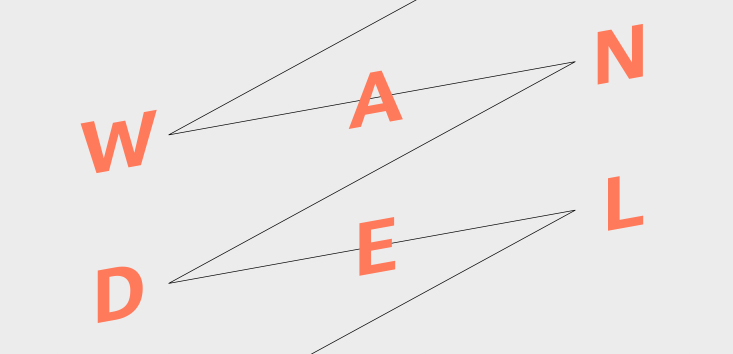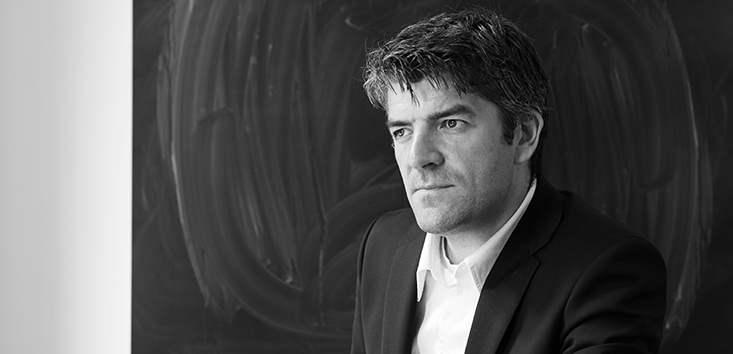»Shaping change«:
As part of the publication »Shaping Change,« corporate communication expert Gabriele Quadt and Valentin Heisters spoke to each other about the work of Heisters & Partner, good design and credible corporate communication in times of change. What does it take to be recognized and valued in today's flood of information? What role does digital transformation play and how can design be used as a strategic value-added factor? Valentin Heisters explains how corporate culture and strategy are effectively combined in corporate communication and which companies, in his eyes, provide outstanding examples of integrated communication.
A question to start with: Are you obsessed with good design?
We love good design and work courageously and consistently to find the best communication solutions. Our enthusiasm and empathy certainly play a big role in this. For us, however, design is never an end in itself, but rather a deeply dialogic process that follows a clearly defined task. In other words, a collaborative effort that would not work without the users, operators and, above all, the clients. We are less obsessed with design itself than with the intention of developing effective answers to our customers' tasks. Ultimately, it's all about the success of the solutions in use.
Heisters & Partner has the subtitle »Corporate & Brand Communication« – what exactly does that mean?
We view the company as a whole as a brand. For us, corporate communication always includes brand communication. »Corporate & Brand Communication« means that our focus is on corporate communication and reporting on the one hand, and corporate design and branding on the other.
What do you think sets your team apart?
I think that, in addition to our know-how, it is our close connection and identification with the individual projects and tasks that ultimately shows in the quality of the work. Over 60% of our customer relationships are significantly longer than five years. One of our customers has the following statement in its principles: »We want to be leaders in everything we do.« Another says that his employees »put their heart into it.« We are very similar. We want the best possible result for the communication tasks that arise and we put our heart into every task we take on. Customers value the entrepreneurial spirit and direct responsibility of everyone on the team. In this respect, we are a reflection of our clients.
But don’t large companies require a more complex structure?
When we realize a project, the customer speaks directly with the responsible art director and concept designer. We do not have a traditional customer contact person who is put in between and mediates between design, text and agency management. This is supported by strong and proven project management, which holds all the threads together. And we do not differentiate between a larger and a smaller company. Our concentration and our uncompromising commitment are always the same.
In addition to digital storytelling, you also develop periodicals, annual reports and corporate identity that have received numerous awards. What characterizes the design and conception at Heisters & Partner?
Maybe this: We win most customers through pitches. Surprisingly, we have to say: We usually win the pitches we take part in. That may sound a bit pretentious, but it's often the case. When we ask our new customers what the difference was between them and the other competitors, the answer is often: You have studied us the most intensively and you have understood us the best.
You create strong image and text concepts. It is noticeable that many of your customers use these in various media channels: was this planned from the start?
It varies. Precisely because we see the company as a whole as a brand, the stories, photo series and image parts of the media we create always contribute to the umbrella brand. Annual report clients, for example, specifically include us in pitches for corporate image campaigns because they have the feeling that our understanding of the company is very strong and apt. Today, we create cross-company imagery and stories that appear in social media, as web stories or as classic image ads and consistently contribute to the corporate brand.
What distinguishes your approach from a traditional advertising agency?
It has been shown that our content-related and conceptual approach, which goes deeper and comes from communication, makes an important contribution to achieving the goals for corporate communication. Because it is not about advertising, but rather, as the word says, it is about communication. It is about the image of the company, which goes beyond the day. And that means building relationships and dialogue with the stakeholders. You could also say: advertising primarily wants attention in order to sell something. But communication wants something else: dialogue and the communication of attitudes and values. Our work is always about exchange and building trust.
What is the common thread of the individual communication measures?
The common thread is clearly stakeholder-oriented communication, with consistent messages and a consistent design appearance, which covers all areas of corporate communication and links digital and analogue channels.
You also produce annual reports, which have undergone a shift from print to digital versions in recent years. Have you noticed a change in annual report concepts?
Yes, concepts have changed in the context of an increasingly broad digital communication culture. This includes, for example, a stronger focus on the relevance of information for stakeholders. Communication today is more comprehensive and closer to the target groups. To use a quote, people have increasingly descended from the general's hill of communication and are working faster, more relevant to the target group and less woodenly than they did a few years ago.
What does this do to the quality of the content? Will everything become a newsroom with a fast pace?
It is getting faster, no doubt about it. But we are also observing something else: quality in communication and the creative mastery of the media, each with its own requirements and potential, is more important today than ever before. The quality of the content and the communication concepts is of crucial importance. All media and events today complement each other. And every reader or user of a communication offering is an opportunity to convey the company's messages, but every user is also sensitive: everything is perceived and evaluated. Against the background of an information culture that has made all information available everywhere at all times, we believe it is worthwhile from a company perspective to do professional work and not to leave the image that is presented to the outside world to chance.
What specific opportunities does the conception of a well-made annual report offer for the company brand?
The annual report can be the decisive driving force for corporate communication, because today corporate communication shapes the entire company brand. Authentic concepts that are coherently derived from a company's corporate identity are the most sustainable beyond the annual report – regardless of the respective media channels. Particularly strong are the concepts that effectively formulate the cultural core of a company as a strategic USP and remain credible.
Is there a concrete example from your work of such a holistic brand presence and the use of a concept in other media?
Yes, last year we were able to convince one of the world's leading specialty chemicals companies of such a concept. We developed an image campaign for ALTANA AG that can be found in all decision-maker-oriented channels, but which also forms the image section of the annual and sustainability report and is also the basis for an internationally produced image film that supports print and accompanies the advertisements via a QR code. But the use is even broader: at the same time, the concept runs as storytelling in social networks, and in employer branding too, the campaign idea controls all personnel advertisements. But something like this only works with a conceptually well-crafted idea that has a truthful core. In our case, it was the authentic story that sets ALTANA apart and makes it unique.
You speak of »truthfulness« in connection with the brand. Isn’t that a bit of an exaggeration?
On the contrary, you depend on a true brand core, a core that is real and allows us to understand the identity. That brings us closer to the origins, the visions, the goals and the uniqueness of a company. If companies succeed in getting to this core identity, recognizing it and deriving a strategy from it that uses the strengths and transforms them into new contexts, this has a very powerful effect.
In your opinion, what role does design play?
Design is a very important aspect whose strategic, emotional and economic power is often underestimated. If a company's strategy can be expressed in a form that corresponds to this inner truth and culture, that emerges from it and is not just »put on« at the end of a process as a facade, then amazingly enough it is recognized intuitively by the recipients and attracts attention in a completely different way. The brand or product suddenly appears independent and very coherent to the viewer. In order for this persuasive power to arise, the design must be developed from an integral process, i.e. that it becomes part of and at the same time an inner expression of the corporate culture. Where this is successful, enormous potential for value creation opens up.
So you see the connection between inner values and external appearance as a prerequisite for the functioning of a brand?
Absolutely. Michael Conrad says: »Make Culture your Strategy«. If the outside of the brand makes the inside visible, or in other words: is the result of an identity process in the best sense, then the chances that the performance potential will be recognized and understood by customers and stakeholders are very high.
What role does communicating a brand’s sustainability play in this context?
This is a crucial point. Let's assume that a company succeeds in creating a convincing unity of product, brand and corporate communication. Perfectly designed, integrally communicated. And now it happens that the newspaper says: The working conditions in the suppliers' factories in China are inhumane and show no consideration for the mental and physical health of the workers! Such crises can threaten the existence of companies. Who wants to buy a lifestyle product or a fancy communication device for which others may have to pay with their lives? Even if everything about certificates and declarations of commitment is theoretically no longer the responsibility of companies: In public perception, this does not matter, because whoever has a decisive share in the value creation and stands for the brand is rightly held responsible by the stakeholders. It's the matter of the integral core: if it's lazy, the whole brand will fall apart.
What does this mean specifically for sustainability communication?
To create transparency and a climate of honesty. It is not about producing advertising messages, but rather about reporting with credible substance about the responsibility that is being lived and the interest in dialogue with stakeholders. Anyone who builds trust here and takes the arguments of critics seriously and responds to them appropriately can count on being listened to in a crisis. A good sustainability report can be very helpful in supporting this, along with other measures. One example is McDonald's, which has many challenging topics to communicate and has shown that this medium can be used very effectively.


Photography: Michael Rast



 Top
Top